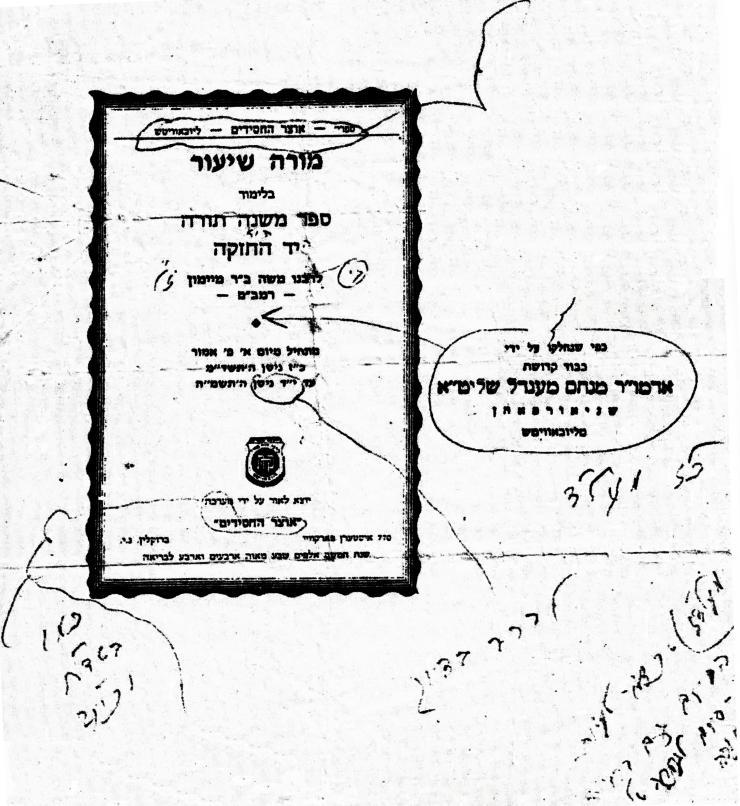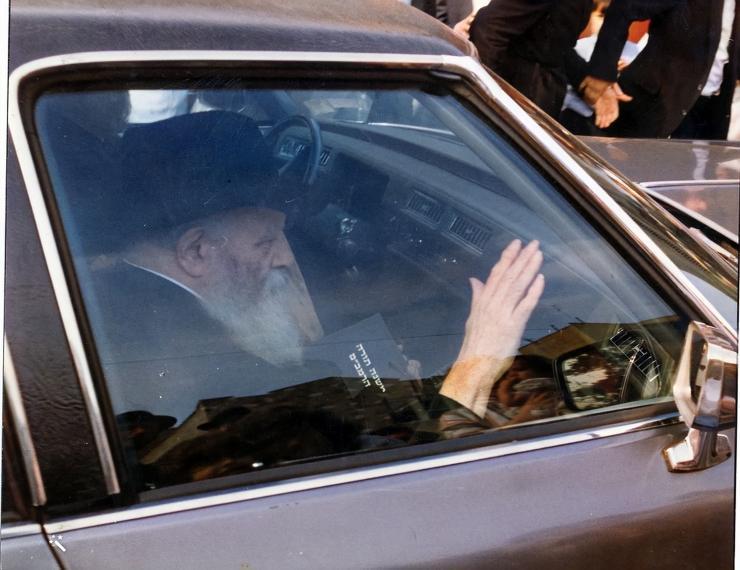Daily Rambam – How It All Began


We commence this week the 45th cycle of the daily Rambam study that the Rebbe Melech HaMoshiach instituted on Yud Aleph Nissan 5744. In this special overview, Beis Moshiach Magazine brings you behind the scenes to the special events (in 770 and in Morocco) that transpired in the months leading up to that historic announcement which changed the daily lives of many thousands, forever • Full Article
By Shneur Zalman Levin, Beis Moshiach Magazine
There was excitement in the air among thousands of Chabad Chassidim on that Monday, 28 Nissan 5744, with the first-time start of the daily study of Yad HaChazaka, starting with the cover page and the introduction written by Rabbeinu Moshe ben Maimon.
Since then, for thirty-nine years, thousands of Chabad Chassidim open the Yad HaChazaka every day and study it. Some learn three chapters a day, some learn one chapter, and some learn Sefer HaMitzvos.
The goal is to unite Am Yisrael with the study of one sefer which encompasses all of the oral Torah, including laws that are not in practice today. This is the goal as stated by the founder of this program, the Rebbe.
Few remember how and when it began. When was it decided which day would be the first of the new study program?
A TAKANA IN STAGES
The beginning was at the farbrengen on Shabbos, parshas Vayeishev, 20 Kislev 5744. The Rebbe said it was time to institute a shared learning program similar to the division of Shas, by learning the Rambam’s Mishneh Torah, with a daily study quota. The Rebbe spoke about learning through the entire work according to the order that the Rambam wrote in his sefer and not only the mesectos of Shas that are learned in yeshivos.
“Unfortunately, there are rabbanim and roshei yeshiva who don’t know entire sugyos of essential topics such as G-d’s unity and the like and this is because they do not learn according to the order established by the Rambam in his work. First, Sefer HaMada, and within Sefer HaMada, the Hilchos Yesodei Ha’Torah, and then all the details of the laws in Orach Chaim and only after that, the laws of money, etc.”
The Rebbe concluded, “May it be that finally, everyone will start learning Torah according to the order established by the Rambam.”
This was the first time this suggestion was made but it remained as a suggestion and wasn’t instantly implemented. The ones who picked up on this were the talmidim-shluchim in Casablanca, Morocco, the city the Rambam lived in for several years. They understood that the Rebbe wanted the study of the Yad HaChazaka to be divided but didn’t know how. The system we are used to today was far from their thoughts.
The bachurim-shluchim decided to reach out to the kollelim, yeshivos and shuls in Morocco to get as many Jews as possible to participate in dividing the study by each person taking on their choice of chapters. Letters were sent to rabbanim and talmidei chachamim in that country:
“In advance of Yud Shevat – 34 years of the Rebbe’s nesius, we are happy to announce that in accordance with a sicha of the Rebbe shlita, we are organizing the division of the fourteen sefarim of the Rambam among all the rabbanim and talmidei chachamim in Morocco, in order to complete the study in honor of 11 Nissan, the Rebbe’s birthday, and 14 Nissan, the Rambam’s birthday.”



The Rebbe’s edits on the first “Moreh Shiur”
The surprising initiative was welcomed enthusiastically by the bnei Torah in Morocco and within two weeks the division of the thousand chapters of Yad HaChazaka had been completed. This created wonderful unity among all factions in the Torah world in Morocco.
Out of all the halachos, the tmimim-shluchim chose to learn “Hilchos Shluchin v’Shutfin” as a symbolic expression of their role as the Rebbe’s shluchim and partners in his holy work in the world.
In Adar I 5744 the tmimim received a letter “klali-prati” from the Rebbe. The very sending of the letter was interpreted by the bachurim as the Rebbe’s expression of nachas. The letter began with the words, “The letter-report and the attached were received and thank you.”
That is how the mivtza began and ended.
TWO DAYS OF INDIVIDUAL LEARNING
Five months passed. At the 11 Nissan farbrengen, the Rebbe made a siyum on the fourteen sefarim of the Rambam’s Yad HaChazaka. The Rebbe did not explicitly connect this with the division of the chapters in Morocco which had just concluded, but the shluchim in Casablanca realized there was a direct connection between the siyum and the project they had organized.
Eleven days later, at the farbrengen on Acharon shel Pesach, the Rebbe again brought up his desire to have the Rambam divided and learned in a systematic way. The Rebbe spoke about this in a general way and suggested they start learning in order and that it was worthwhile finishing it by the Rambam’s birthday, erev Pesach 5745. Additional details were yet to be said. The Rebbe mentioned the Rambam initiative that the bachurim made in Morocco:
“It has been a number of years that I waited, perhaps they would be inspired to do so, regarding learning Rambam, until finally, they were roused in one of the countries of our brothers, the Sefardim, to divide the Rambam’s sefer in such a way that each one committed to a certain part. They completed the Rambam close to the Rambam’s birthday this year.”
The Rebbe even said, “I tried to talk about and urge regarding this matter a number of times and, to date, I have been unable to accomplish that such a takana be made. If only this would be done from now on.”
The day after the farbrengen, when word of the takana reached around the world, the Chassidim immediately began learning Rambam, each according to his personal schedule. The Rebbe’s initiative had gotten off the ground but nobody yet knew how to go about it.
This individual learning continued for two days until the sicha that was said at the “yechidus klalis” for guests on Thursday, 24 Nissan. In this sicha, which was broadcast to the world by phone, the Rebbe suggested the main points of the takana and its details, with the main point being completing the sefer every year with the first round finishing erev Pesach 5745. The Rebbe mentioned that the Rambam has a thousand chapters and in order to finish it annually, three chapters had to be learned each day. This way, said the Rebbe, they would be able to finish the Rambam on the “yom zakai” – erev Pesach or thereabouts.
It’s interesting to note that they finished on a “yom zakai” – 11 Nissan.



The Rebbe said that for those for whom learning three chapters a day would be too much, they could learn one chapter a day and finish every three years. And since, in the middle of the three year cycle there would be a leap year, they would finish by the Rambam’s yahrtzeit, 20 Teves (5747).
The Rebbe noted the advantage in shared learning: when everyone learned all the halachos of the Torah it created terrific unity among Am Yisrael and it led to a common language of learning among those who learned it all over the world; they are able to discuss and innovate on the same topic.
The day after the yechidus klalis, Friday, 25 Nissan, the Rebbe issued a response to someone who apparently had written that it would be too hard for him to learn three chapters a day. The Rebbe said: In the sicha it was stated that there is another option, to learn one chapter a day, and it seems this pertains to you.
AS DIVIDED BY THE REBBE SHLITA
At first, nobody knew where to begin and how to set up the division into daily shiurim. That same night, the members of the Vaad L’Hafotzas Sichos worked to divide the Rambam into three chapters a day and one chapter a day in order to produce a “schedule” that would serve as a guide for those who learned the daily portion of Rambam. When they were done, they submitted it to the Rebbe for his approval. The Rebbe sent it back out, approving how the division was set up. The Rebbe even approved writing an introduction which said that the division was instituted by him.
They published a “moreh shiur” before Shabbos so that on Sunday, every Jew would be able to do the Rebbe’s wishes and learn the daily Rambam as it was divided with the Rebbe’s approval.
In coming years, the Rebbe was involved in every detail having to do with the “moreh shiur.” Every year, the Rebbe chose the date of the “pesach davar” of the new “moreh shiur.”
Before the second “moreh shiur” was published, the editors asked the Rebbe about the learning to be done on Tisha B’Av which, that year, was on Shabbos. The Rebbe responded in a handwritten note that they should note in a footnote that one should ask a rav-moreh horaah when to learn it. In a note for Sunday (a postponed fast day), they should write it should be learned after havdala. The members of the editorial team received additional instructions from the Rebbe which were printed in the margin of the “moreh shiur.”
The “moreh shiur,” which became an inseparable part of daily life for a Chassid, took on an official form.
A HISTORIC MOMENT IN LUBAVITCH
There was a feeling of excitement in anticipation of the upcoming farbrengen, Parshas Kedoshim. The tmimim speculated that the Rebbe would talk about the Rambam’s introduction which would be learned as the start of the cycle on the next day, Sunday.
They were right. In the third sicha, the Rebbe spoke at length about the new takana. He explained the reason for the takana, to unite the Jewish people with learning that encompassed the entire Torah. He said that since the takana is meant to unify, women and children should be included and therefore, there would be a third track of learning: Rambam’s Sefer HaMitzvos. This track would parallel the track of three chapters a day. The Rebbe asked that his suggestion and request be widely publicized. He noted that someone who heard about it later on could join the learning even in the middle.
On Sunday there was the official start to the learning of Rambam daily with the participation of rabbanim, mashpiim and senior Chassidim. In honor of the launch, pamphlets of “moreh shiur” were also published for the one chapter a day and for Sefer HaMitzvos.



The Rambam L’Am edition on the Rebbe’s table in the library building when he met with Chief Rabbi Mordechai Eliyahu zt’l.
The chozer, Rabbi Yoel Kahn reviewed the Rebbe’s sicha of the previous Shabbos and the mashpia, Rabbi Sholom Morozov learned the Rambam’s introduction with the crowd.
Throughout that week, one could see Chabad Chassidim flocking to sefarim stores and buying sets of Rambam. Within a short while, booksellers said it was impossible to buy sets of Rambam in most sefarim stores. Publishers, seeing a good business opportunity, quickly published additional editions of the Yad HaChazaka.
In the following weeks and months, learning Rambam became a universal activity. In yeshivos, you could see bachurim discussing points in the Rambam. In 770, there was a daily shiur for balabatim given by R’ Sholom Morozov and there was a daily shiur for the members of the kollel. Shiurim on Rambam were started wherever Anash lived and wherever their influence reached.
The hanhala of a Chabad yeshiva in the US wrote to the Rebbe saying they thought time should be devoted to learning the daily Rambam during one of the yeshiva’s sedarim. The Rebbe said no. “Learning Mishneh Torah is not part of the yeshiva’s seder ha’limud, obviously.”
Since then, the takana continues to gain adherents with tens of thousands of Jews worldwide who learn the halachos in the Rambam using whichever track suits them. Many shiurim are given in Chabad Houses and Anash communities.
I NEVER IMAGINED
About a year later, the night of Rosh Chodesh Iyar 5745, R’ Gershon Ber Jacobson, editor of the Algemeiner Journal had yechidus. The Rebbe said to him, “The entire matter of the Rambam was, as the Rebbe Maharash says, l’chatchila ariber. I did not imagine that the study of Rambam would ‘catch on’ so much in one year.”
*
Beis Moshiach magazine can be obtained in stores around Crown Heights. To purchase a subscription, please go to: bmoshiach.org
614
Join ChabadInfo's News Roundup and alerts for the HOTTEST Chabad news and updates!








































